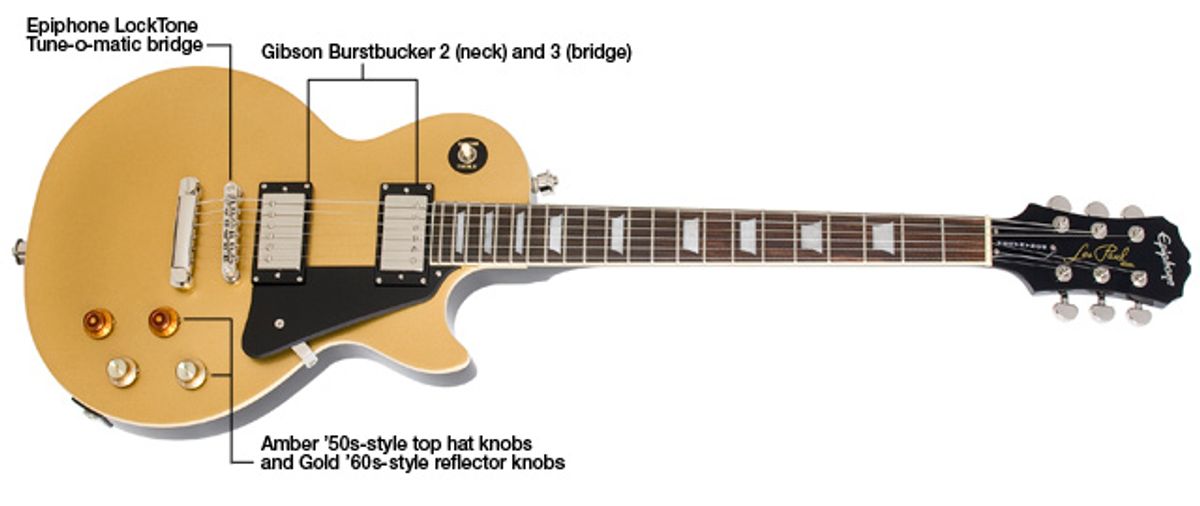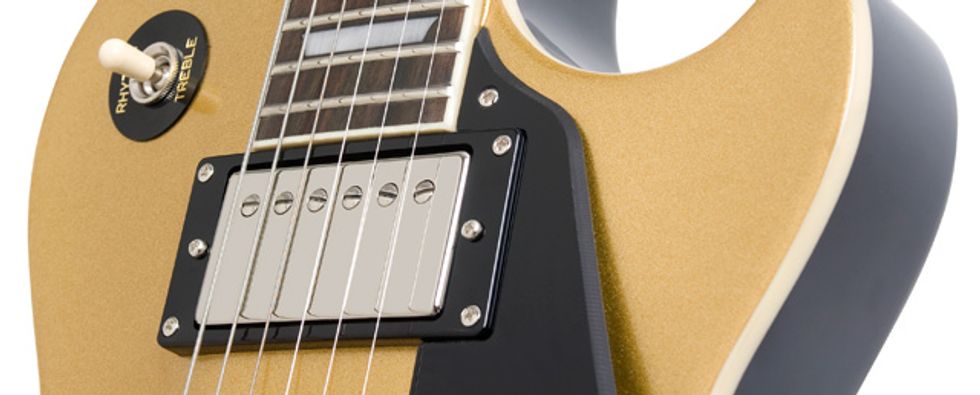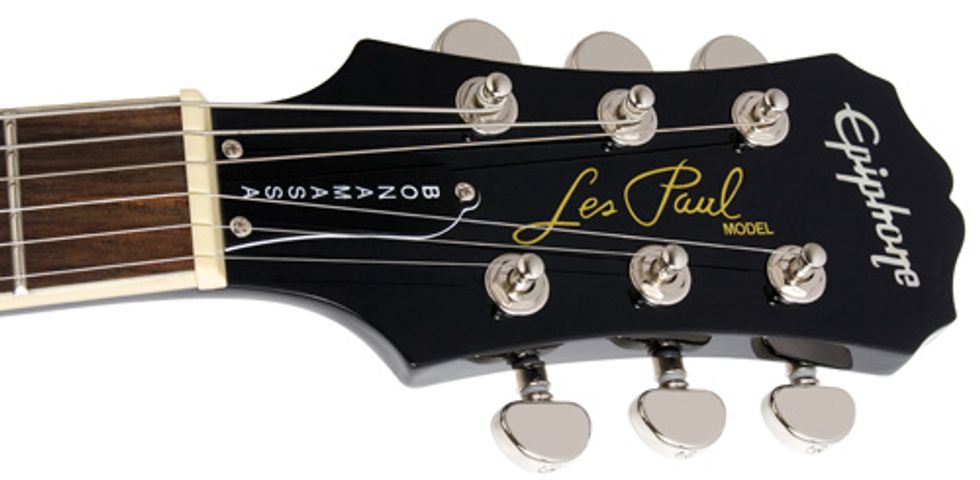
For those with thinner billfolds, Epiphone has released a special version of Gibson’s Bonamassa model—retailing for less than a fifth of the price and limited to 1,000 instruments.
| Download Example 1 Neck Pickup |
|
| Download Example 2 Bridge Pickup |
|
| Clips recorded using Fender Pro Junior, Planet Waves Custom Pro cables, Fryette S.A.S. and Apogee Duet into GarageBand. | |
Student of the Old School, a Foot in the New…
The Epiphone Bonamassa model is very much a traditional Les Paul, built around a solid mahogany body, a hard maple cap, and a thick mahogany neck with an old-style long tenon that extends well into the neck pocket for strength and sustain. Other traditional appointments on the Bonamassa include a rosewood fretboard with pearloid trapezoidal inlays and single-ply crème binding around the neck and the top of the body.
 The Bonamassa departs from tradition a bit too. It’s got a black-painted back where the original Goldtop’s is natural mahogany. And while a ’50s Les Pauls has crème pickup surrounds, pickguard, toggle-switch washer and tip, those parts on this guitar are all black. Instead of Kluson tuners, with their green plastic buttons, the Bonamassa is equipped with higher-performance 14:1 Grovers. Other modern touches include Epiphone’s LockTone Tune-o-matic bridge, stopbar tailpiece, and strap locks. And the control panel includes the eccentric combination of two amber ’50s-style top hat knobs and two gold ’60s-style reflector knobs (though in this reviewer’s opinion, the guitar would look better with a matched quartet of black reflector knobs).
The Bonamassa departs from tradition a bit too. It’s got a black-painted back where the original Goldtop’s is natural mahogany. And while a ’50s Les Pauls has crème pickup surrounds, pickguard, toggle-switch washer and tip, those parts on this guitar are all black. Instead of Kluson tuners, with their green plastic buttons, the Bonamassa is equipped with higher-performance 14:1 Grovers. Other modern touches include Epiphone’s LockTone Tune-o-matic bridge, stopbar tailpiece, and strap locks. And the control panel includes the eccentric combination of two amber ’50s-style top hat knobs and two gold ’60s-style reflector knobs (though in this reviewer’s opinion, the guitar would look better with a matched quartet of black reflector knobs).
Electronics include Gibson’s Burstbucker 2 and 3 pickups in the neck and bridge positions, respectively. The 2, which has a medium output, is wound in the range of Gibson’s ’57s Classic and patterned after the original P.A.F. humbucking pickup. The 3 is over-wound for a slightly hotter sound that works well in concert with the 2. Both pickups are controlled by a standard three-way switch.
Bonamassa’s Epi comes inside a very cool case patterned after the classic Lifton “Cali Girl,” brown on the exterior and pink on the interior, but featuring sturdy modern construction—a scheme that Gibson Custom ought to use in its Historic line of ’50s reissues. It also includes a certificate of authenticity hand-signed by Bonamassa himself.
Craftsmanship on our Chinese-made test model is quite good. The fretwork is super tidy and the slots for the nut and saddles are cleanly cut. The neck is situated solidly in its pocket and the binding is tight and flush throughout. A hint of an orange-peel effect can be found here and there on the finish, which seems just a bit thick, but then again it is not uncommon to find this subtle irregularity on guitars at many times the price.
Heavy Feel, Heavy Sound
When I removed the Epiphone Bonamassa from its case, the first thing I noticed was that it was pretty heavy at 9.5 pounds. (Most Gibson Historics, for reference, weigh in at less than nine.) The neck, with its rounded ’50s “D” profile—the contour that Gibson Custom features on the 1959 Historic Reissue—also felt pretty massive. I generally find this neck to be exaggeratedly large and not very comfortable, but it didn’t take long before it felt pretty natural given the overall heft of the guitar.
The guitar came from the factory with smooth, low action. The 24.75-inch scale neck was comfortable from the open position to the 22nd fret and was hospitable to barre chords with big stretches and rapid-fire single-note lines alike. However, the guitar felt slightly stiff when I bent some strings more than a half step, and the tuning was sometimes negatively affected by the bends.

No Bones About the Sound
To test the guitar, I used a Fender Pro Junior amplifier and, in certain contexts, a Freyette S.A.S. distortion pedal. With this streamlined setup the Bonamassa sounded great, and it’s unlikely that a blindfolded listener would be able to identify it as a $700 import.
Overall, I find the combination of Gibson’s 1 and 2 Burstbuckers seen in the Historic Les Pauls to be a little smoother than the 2 and 3 package, but the latter really shone in the context of the Bonamassa model. On the neck pickup, it was easy to get a sustaining violin-like tone for blues-rock riffing and soloing. With the tone and volume rolled back, the pickup sounded just warm enough for jazz and worked nicely for some single-note bebop lines as well as some Wes Montgomery–style octaves and chord melodies. In a completely different direction, I was able to get a massive metal sound with an ample amount of clarity by tuning the guitar to drop D and dialing in a crushing amount of distortion on pedal, even with the Junior, a super compact amp.
When played in tandem, the neck pickup took a little of the edge off its bridge-position mate but didn’t blunt the attack. This was my favorite setting; it delivered excellent rhythm and lead tones
The bridge pickup had a nice bite and none of the muddiness sometimes associated with humbuckers. While slightly edgy on account of its higher output, it accurately reported every little detail and worked equally well for a cutting solo in A minor pentatonic, a bit of Brian Setzer–approved soloing, and some crunchy rhythm work in both standard and open G tunings. It sounded great for some slide playing in the latter, though the action was of course a bit low.
When played in tandem, the neck pickup took a little of the edge off its bridge-position mate but didn’t blunt the attack. This was my favorite setting; it delivered excellent rhythm and lead tones and, with adjustments on the S.A.S. pedal, proved impartial to genre.

The Verdict
Epiphone’s limited-edition Joe Bonamassa Les Paul is a smart, affordable guitar that borrows certain features—like a long neck tenon joint and Burstbucker pickups—from its more costly Gibson counterparts. It retails for a fraction of the price of a top-of-the-line Les Paul from Gibson’s Custom Shop but plays and sounds superb. And, given the guitar’s scarcity, it would make an excellent investment for the diehard Bonamassa fan. But whether you’re as Bonamassa loyalist or fan of great affordable Les Pauls, you should plan on moving fast if you’re interested. 1,000 guitars this good, this inexpensive, won’t last very long.
Buy if...
You want a nice Les Paul but can’t afford a USA or Historic model, or if you’re way into Joe Bonamassa.
Skip if...
you only play American-made guitars or you’ve got a stable of Historic Les Pauls.
Rating...
|
Street $699 (with hardshell case) - Epiphone - epiphone.com
|

